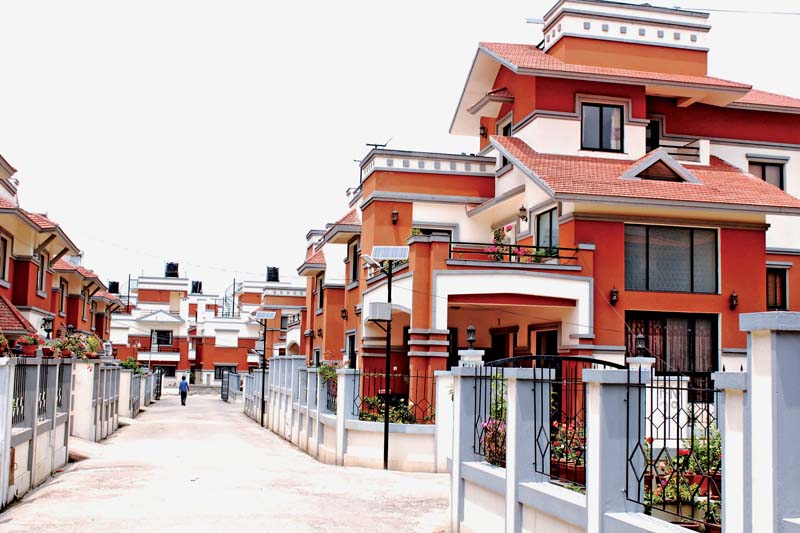Nepal’s housing landscape is changing rapidly. From rising demand in urban areas to traditional homes in rural villages, the housing situation in Nepal reflects both challenges and opportunities. In this blog, we’ll explore the current status of housing across the country, trends shaping the market, issues people face, and what the future holds.
Whether you’re a student, family, investor, or policymaker, this blog helps you understand the realities of Nepal’s residential infrastructure today.
What is the housing like in Nepal?
The housing landscape in Nepal is diverse. It ranges from traditional mud-and-brick homes in rural areas to high-rise apartments and luxury villas in major cities like Kathmandu, Pokhara, and Bharatpur.
Here’s a quick overview:
| Region | Common Housing Type | Situation Summary |
| Rural Nepal | Mud-brick houses, thatched roofs | Basic housing, limited amenities |
| Kathmandu Valley | Apartments, villas, colony houses | High demand, limited supply, rising property costs |
| Urban Towns | RCC buildings, mid-rise flats | Expanding fast, but lacking planning |
Key Factors Affecting Housing in Nepal:
- Urban migration from villages to cities
- High land prices in Kathmandu Valley
- Limited access to affordable rental housing
- Earthquake recovery and need for earthquake-resistant homes in Nepal
- Informal settlements expanding without proper planning
Types of Housing in Nepal
- Traditional Homes
– Found in villages; made of stone, mud, or wood.
– Often lack modern amenities. - RCC Houses
– Popular in towns and cities.
– Provide durability and long-term safety. - Apartments and Flats
– Increasingly common in Kathmandu and Pokhara.
– Favored by professionals and small families. - Housing Colonies
– Organized gated communities offering better security and amenities.
– Ideal for family-friendly housing and long-term living. - Rental Homes
– Rented rooms or floors in private houses dominate the urban housing scene.
– Good for students and working professionals.
Urban vs Rural Housing: The Contrast
| Aspect | Urban Housing (e.g., Kathmandu) | Rural Housing (e.g., Terai, Hilly regions) |
| Type | Concrete apartments, colony houses | Mud/stone houses, thatched roofs |
| Access | Better water, electricity, roads | Limited access to modern facilities |
| Risk | Overcrowding, rental stress | Weather vulnerability, lack of quake-resistance |
| Cost | Very high land & building prices | Comparatively low but rising |
In many cities of Nepal, planned housing like gated communities and housing colonies are being built to reduce crowding. But even with these new developments, houses are still too costly for most people, making it hard to afford a home.
Common Housing Issues in Nepal
Despite growing developments, here are some common housing issues in Nepal,
| Issue | Details |
| Affordability | Land and building costs are high in cities |
| Overcrowding | Dense population in Kathmandu causes strain |
| Rental Problems | Lack of regulation and fair pricing |
| Unsafe Construction | Many old homes still vulnerable to disasters |
| Poor Planning | Uncontrolled urban expansion in valley cities |
Government Policies & Housing Initiatives
The Government of Nepal has introduced several policies to improve the housing situation:
- People’s Housing Program: Focused on low-income rural families.
- Affordable Housing Projects: In partnership with private developers in cities.
- NRN Property Rights: Simplified laws for NRNs to invest in Nepali real estate.
- Earthquake Reconstruction Aid: Support for rebuilding earthquake-affected homes.
Still, execution is slow, and housing policies in Nepal need updates to tackle the growing urban population and climate-resilient infrastructure needs.
Growing Urban Housing Trends in Nepal
| Trend | Description |
| Smart Homes | Integration of tech, security systems, and energy-efficient designs. |
| Housing Colonies | Planned neighborhoods with common facilities. |
| Eco-Friendly Housing | Solar panels, rainwater harvesting, and green roofs. |
| Vertical Living | Apartments and high-rises are rising due to land shortages. |
Price Range of Homes in Major Cities
| City | Average House Price (2025) |
| Kathmandu | NPR 2.5 – 8 crore |
| Pokhara | NPR 1.5 – 4.5 crore |
| Lalitpur | NPR 2 – 6 crore |
| Chitwan | NPR 80 lakh – 3 crore |
| Bhaktapur | NPR 1.5 – 5 crore |
Note: Prices vary based on location, size, road access, and builder reputation.
Future of Housing in Nepal
Looking ahead, Nepal’s housing future depends on sustainable planning, technology, and investment.
Likely Trends:
- More planned housing in Nepal’s urban centers
- Increased demand for earthquake-resistant construction
- Smart, green housing projects
- Focus on urban housing in Nepal that is affordable and accessible
- Growing interest in NRN property in Nepal, especially in gated colonies
FAQs – Housing Situation in Nepal
1. Is housing affordable in Kathmandu?
Not for most. Prices are high, especially inside the Ring Road. Outer areas offer better value.
2. Can NRNs invest in housing in Nepal?
Yes. Recent regulations allow NRNs to buy and invest in real estate with proper documentation.
3. What’s the biggest housing challenge in Nepal?
Affordable housing and disaster-safe construction remain the top two concerns.
4. Are housing colonies the future of urban living?
Yes. Many families now prefer gated community homes with security, planning, and resale value.
Conclusion
Nepal is at a turning point in its housing journey. The shift from traditional, informal homes to planned urban housing and gated colonies shows promise — but it must be supported by smart policy, strong construction codes, and inclusive investment.
If done right, Nepal can achieve safer, more affordable, and environmentally-friendly homes for all.
Whether you’re looking to invest in real estate in Nepal, buy a house in Kathmandu, or understand the future of urban housing in Nepal, staying informed is the first step.

